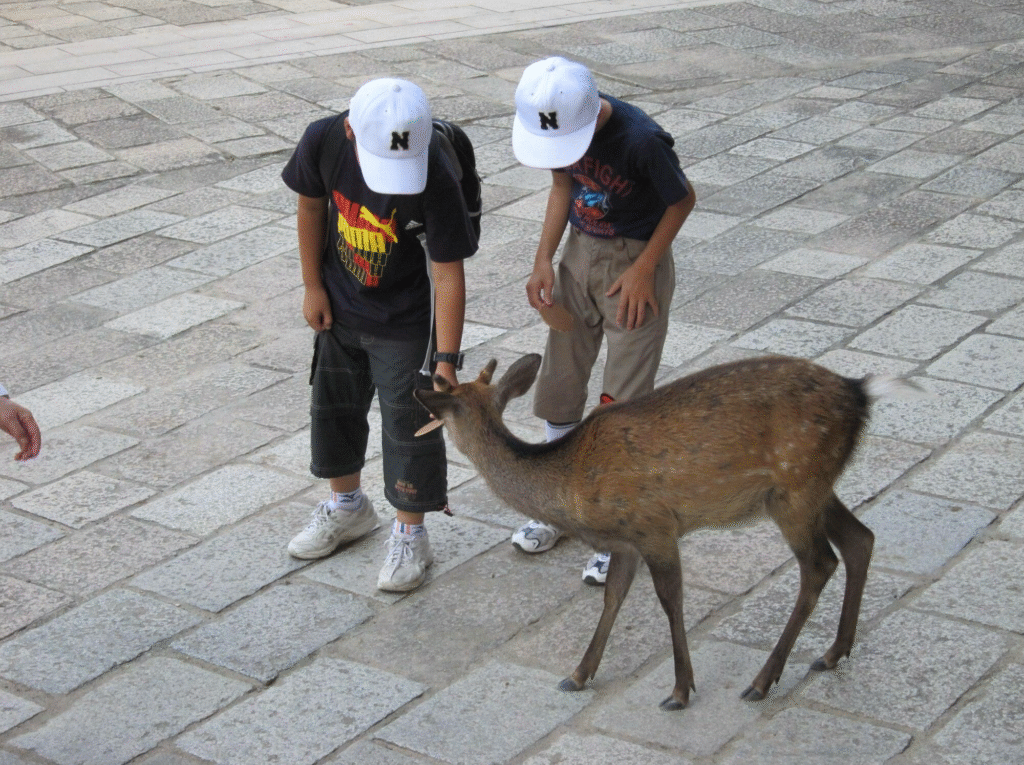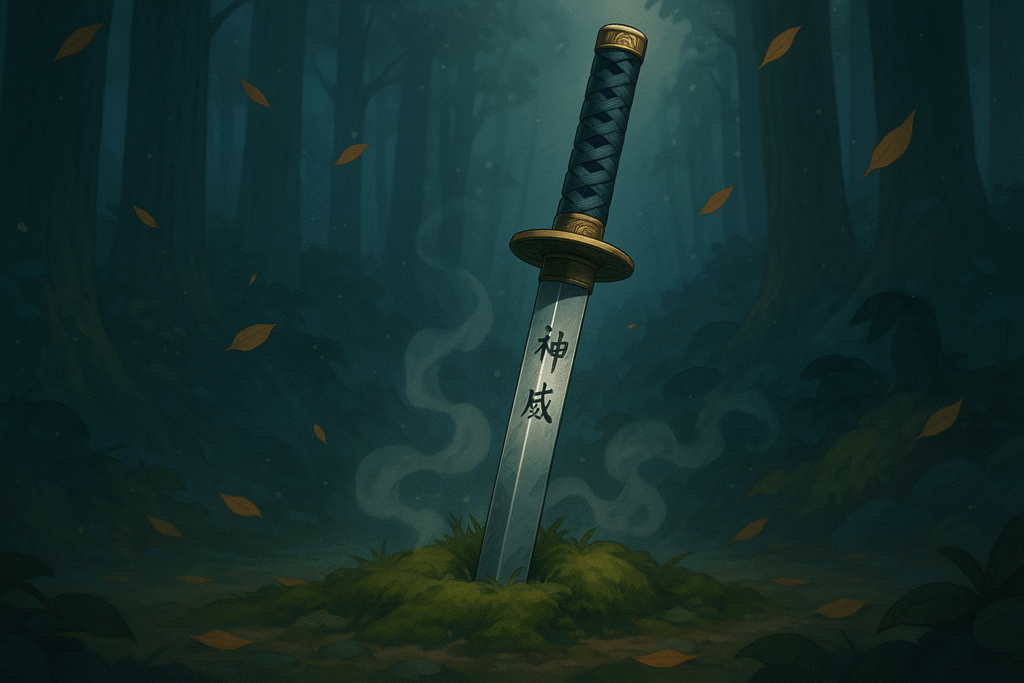Japan is famous for many things: from ancient samurai to sashimi and of course, anime. One thing some might not think of, though, is the wildlife.
You often read about Japanese macaques up in the mountains and pufferfish on people’s plates, but they aren’t Japan’s only national celebrities.
In the city of Nara live roughly 1,300 free-roaming sika deer (Cervus nippon). Each year, about 13 million tourists visit Nara Park to meet the deer up close and personal.

Image Credit: John Gillespie, Wikimedia Commons
There are human singers who don’t have as big of a fanbase. The only thing holding these deer back is they can’t sign a record deal yet; God help us if they grow thumbs.
But every year in the summer, they come together in a great gathering. They go to the same place at the same time every day, leaving visitors and park management stumped. These remarkable “shikadamari” or “deer pools” have become a local phenomenon.
Want to learn Japanese faster?
Book a free 15-minute call to create your personalized study plan. Get expert tips, guidance, and answers to all your questions. One-on-one!
Diving into Deer Pools
Back in August 2019, a reporter named K. Masami was doing reporter stuff for Japanese news site SoraNews24 when she first witnessed the deer.
During the evenings, the deer meet and start sitting outside the Nara National Museum like they’re attending a cult sabbath. Luckily, Masami wasn’t sacrificed by them.

Image Credit: 663highland, Wikimedia Commons
These meetings would start at around 18:30 or 6:30 pm in American time. The numbers would soon peak just before 7 pm. Shortly afterwards, they all stand up and go. They just leave.
They do this at the same place at the same time for about the same duration. Every. Single. Day. Without fail. That’s probably the most baffling part. These deer have better punctuality than the trains I take. Masami paid a visit to Nara Park again in 2020 during the COVID-19 pandemic. Just like clockwork, the deer were clustered there in shikadamari. However, she noticed there were far fewer deer than the year before.
In July 2021, Masami had been to the park for an early visit. The shikadamari were still there; when she went back in August, she saw something unexpected: no deer. None of the deer were in shikadamari. They were all more widely spread out. Fortunately, their numbers have slowly been bouncing back since 2023 when Masami saw 20 deer, and more in 2024. These numbers still make 2019’s look like a BTS concert.
Current Theories
As Japan’s top reporter on Nara’s deer, Masami has spent more time around them than most. This has given her time to come up with her own hypotheses. “To understand the deer, one must become the deer”.
The first hypothesis is the deer gather in that one specific spot to cool themselves. There’s a very large and conveniently placed vent in that area. But then why are they crowded so close to each other? Nobody likes being in a bus filled with people in the summer. Everybody is hot, everybody is humid and everybody is sweating. Although deer can’t sweat. Also, if the vent is what’s attracting them then it would seem the deer have not yet discovered cooling yourself with water.
Except for these guys:

Image Credit: Hahifuheho, Wikimedia Commons
The second hypothesis is they’re just waiting for Hiroyuki Sanada to come visit them one day. Further evidence is required to support this.
The third is that the gatherings are somehow related to the visitor numbers. With more weak-willed tourists they can prey on and bribe with cute selfies, the deer get fed more senbei crackers. With more food, they don’t have to conserve energy lying down together in shikadamari.

Image Credit: Natasha Suslina, Wikimedia Commons
Right now, Masami is one of the best sources of information on this bizarre behavioural pattern. But she’s not alone.
My Investigating
While looking for answers, I thought “who better to ask than the people in charge of the deer?”
So I emailed Rie Maruko – a veterinarian who works for the Nara Deer Preservation Foundation – to which she responded back. Her response read as follows:
“At first, I have to tell you that we know little about shikadamari, such as when it started and why deer gather. I do not think that we can provide enough information that you want to know”.
That made me go back to square one. I read through Masami’s report articles and how many deer she had seen each year. Next I read some beautiful tourism statistics and how many visits Japan had each year.
I then did what university spends a year teaching…I made some graphs.

There’s definitely a positive correlation between visit numbers and deer numbers. But does correlation equal causation?
From what I understand, the deer congregate just opposite the Nara National Museum. On the museum’s website, it says it’s “located in a corner of Nara Park”. This would suggest that it’s somewhere on the edge of the park. After taking a little walk through Nara via Google Maps, I discovered the museum is right next to a busy main street. Busy means people. And the deer know that.

Image Credit: Google Maps
My Hypothesis
I think the reason why shikadamari form at this same place, at the same time is because there are more children around to feed them.

Image Credit: Alberto Garcia, Wikimedia Commons
During the day, they get constantly approached and fed by families. But from 6:30 to 7:00 pm, it’s late and the children have all gone home to play Minecraft. At this time, the people who are walking around outside are couples going on dates, teenagers going on a night out, etc. That’s what normally happens for most of the year; there’s one new external factor that comes in summer: the kids go on their summer holiday.
For most schools in Japan, the summer holidays start on the 20th of July. This is about the same time of year when Masami first notices the shikadamari forming. Because these children aren’t in school, they have a lot more free time to go out and do stuff with their family. And they can stay out later.
When the children from other areas in Japan visit Nara on holiday, they could be having dinner at a restaurant or on an evening stroll with family. In a last-ditch effort to persuade these kids to feed them crackers, the deer form shikadamari to gain their attention. The deer are basically doing their version of busking. And similar to actual human buskers (e.g. guitar players) these deer have chosen a very strategic spot.
It’s a lot more eye-catching if you’re in a strange giant group of deer gathered near a famous museum than if you’re just one deer by yourself. So there’s a better chance someone will walk up to you and feed you whatever they’ve got. Prior to the pandemic, this scenario had to have played out quite frequently; enough for the deer to make it part of their routine. But on the 12th of July 2021, Japan declared its fourth state of emergency (SoE) in Tokyo.
This lasted from the 12th of July up until the 12th of September and was one of the longest and most severe SoEs Japan’s ever enacted for COVID-19. Combine this with global travel restrictions, and the park’s visitor numbers plummeted over the summer.

Image Credit: Syced, Wikimedia Commons
Even after all the restrictions have been lifted, the deer are still getting used to people being outside again and restarting their old routine. That’s why shikadamari numbers still aren’t what they used to be. Let’s hope Masami will see more of them this year. I’d fly there to see them myself but I’m already spending a fortune to learn graphs.
Love Japan? Stay in the Loop!
Get the best of Japan straight to your inbox: language, culture & travel insights!
Sources List
- https://www.japan.travel/en/experiences-in-japan/5876/
- https://web-japan.org/trends/11_food/jfd202101_fugu.html
- https://news.mongabay.com/2024/05/messengers-of-the-gods-naras-sacred-deer-at-a-conservation-crossroads/
- https://soranews24.com/2024/07/31/nara-deer-shikadamari-phenomenon-continues-to-baffle-visitors-at-nara-park/
- https://soranews24.com/2019/08/20/shikadamari-the-nara-deer-summer-gathering-phenomenon-that-baffles-visitors-every-year/
- https://soranews24.com/2020/08/20/deer-in-nara-park-outnumber-visitors-perform-baffling-summer-gathering-phenomenon/
- https://soranews24.com/2021/08/17/deer-in-nara-park-mysteriously-disappear-during-this-years-shikadamari-season/
- https://soranews24.com/2023/08/19/nara-deer-shikadamari-mystery-deepens-as-tourists-return-to-nara-park/
- https://www.asahi.com/sp/ajw/articles/15047851
- https://www.tourism.jp/en/tourism-database/stats/inbound/
- https://www.narahaku.go.jp/english/about/
- https://web-japan.org/kidsweb/explore/calendar/april/schoolyear.html
- https://www.asahi.com/sp/ajw/articles/14390347
- https://www3.nhk.or.jp/nhkworld/en/news/backstories/1729/



